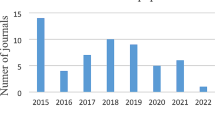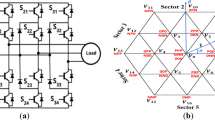Abstract
Rotational speed sensor is one of the most important components used in wind energy conversion system control strategies. The latter is very expensive and may be faulty due to the harsh environment working, causing by that a low efficiency operation of the system. The use of a speed estimator or an observer may be a good alternative solution for the use either in sensorless control or detecting the sensor failure or degradation (FDI and FTC), provided that the observer is robust and ensures high rotational speed estimation accuracy. This paper presents a comprehensive study to solve the optimization problem of a model reference adaptive speed (MRAS) observer in a typical wind energy generation system based on permanent magnet synchronous generator using five adaptation mechanisms: The first one is the classical MRAS observer; it is based on proportional–integral (PI) controller. The second one uses a fuzzy logic controller (FLC) with two inputs. The third one uses the single-input fuzzy logic controller which represents the simplification of the conventional FLC. The fourth one uses the sliding mode controller, and the last one uses the super-twisting algorithm. A detailed comparison between the five adaptation mechanisms is carried out. The obtained results show a good estimation stability as well as a fast speed estimation at dynamic regime for the improved adaptation mechanisms compared with the conventional PI controller.



























Similar content being viewed by others
References
Al-Ghossini H et al (2016) Adaptive-tuning of extended Kalman filter used for small scale wind generator control. Renew Energy 85:1237–1245
Carranza O et al (2011) Comparative study of speed estimators with highly noisy measurement signals for Wind Energy Generation Systems. Appl Energy 88(3):805–813
Brahmi J, Krichen L, Ouali A (2009) A comparative study between three sensorless control strategies for PMSG in wind energy conversion system. Appl Energy 86(9):1565–1573
Cardenas R et al (2005) MRAS observer for sensorless control of standalone doubly fed induction generators. IEEE Trans Energy Convers 20(4):710–718
Ramesh T, Panda AK, Kumar SS (2015) Type-2 fuzzy logic control based MRAS speed estimator for speed sensorless direct torque and flux control of an induction motor drive. ISA Trans 57(2015):262–275
Kim H-W, Sul S-K (1996) A new motor speed estimator using Kalman filter in low-speed range. IEEE Trans Ind Electron 43(4):498–504
Qiao W, Yang X, Gong X (2012) Wind speed and rotor position sensorless control for direct-drive PMG wind turbines. IEEE Trans Ind Appl 48(1):3–11
Fantino R, Solsona J, Busada C (2016) Nonlinear observer-based control for PMSG wind turbine. Energy 113:248–257
Aubrée R et al (2016) Design of an efficient small wind-energy conversion system with an adaptive sensorless MPPT strategy. Renew Energy 86:280–291
Echchaachouai A, El Hani S, Hammouch A (2018) Comparison of three estimators used in a sensorless MPPT strategy for a wind energy conversion chain based on a PMSG. Przegląd Elektrotechniczny 94:18–22
Lin W-M, Hong C-M, Cheng F-S (2011) Design of intelligent controllers for wind generation system with sensorless maximum wind energy control. Energy Convers Manag 52(2):1086–1096
Khlaief A, Boussak M, Chaari A (2014) A MRAS-based stator resistance and speed estimation for sensorless vector controlled IPMSM drive. Electr Power Syst Res 108:1–15
Gadoue SM, Giaouris D, Finch JW (2010) MRAS sensorless vector control of an induction motor using new sliding-mode and fuzzy-logic adaptation mechanisms. IEEE Trans Energy Convers 25(2):394–402
Yan J et al (2013) Improved sliding mode model reference adaptive system speed observer for fuzzy control of direct-drive permanent magnet synchronous generator wind power generation system. IET Renew Power Gener 7(1):28–35
Panda AK, Ramesh T, Kumar SS (2016) Rotor-flux-based MRAS speed estimator for DTFC-SVM of a speed sensorless induction motor drive using Type-1 and Type-2 fuzzy logic controllers over a wide speed range. Int Trans Electr Energy Syst 26(9):1863–1881
Cirrincione M, Pucci M (2005) Sensorless direct torque control of an induction motor by a TLS-based MRAS observer with adaptive integration. Automatica 41(11):1843–1854
Zhao Y et al (2013) A review on position/speed sensorless control for permanent-magnet synchronous machine-based wind energy conversion systems. IEEE J Emerg Sel Top Power Electron 1(4):203–216
Abdullah MA et al (2012) A review of maximum power point tracking algorithms for wind energy systems. Renew Sustain Energy Rev 16(5):3220–3227
Eltamaly AM, Farh HM (2013) Maximum power extraction from wind energy system based on fuzzy logic control. Electr Power Syst Res 97:144–150
Zhang Z et al (2014) A space-vector-modulated sensorless direct-torque control for direct-drive PMSG wind turbines. IEEE Trans on Ind Appl 50(4):2331–2341
Errami Y, Ouassaid M, Maaroufi M (2015) A performance comparison of a nonlinear and a linear control for grid connected PMSG wind energy conversion system. Int J Electr Power Energy Syst 68:180–194
Krishna SM, Daya JLF (2016) MRAS speed estimator with fuzzy and PI stator resistance adaptation for sensorless induction motor drives using RT-lab. Perspect Sci 8:121–126
Farhat M, Barambones O, Sbita L (2015) Efficiency optimization of a DSP-based standalone PV system using a stable single input fuzzy logic controller. Renew Sustain Energy Rev 49:907–920
Choi BJ, Kwak SW, Kim BK (2000) Design and stability analysis of single-input fuzzy logic controller. IEEE Trans Syst Man Cybern Part B (Cybern) 30(2):303–309
Choi BJ, Kwak SW, Kim BK (1999) Design of a single-input fuzzy logic controller and its properties. Fuzzy Sets Syst 106(3):299–308
Yadav AK, Gaur P (2014) Robust adaptive speed control of uncertain hybrid electric vehicle using electronic throttle control with varying road grade. Nonlinear Dyn 76(1):305–321
Bouafassa A, Rahmani L, Mekhilef S (2015) Design and real time implementation of single phase boost power factor correction converter. ISA Trans 55:267–274
Derbeli M et al (2017) Control of PEM fuel cell power system using sliding mode and super-twisting algorithms. Int J Hydrogen Energy 42(13):8833–8844
Acknowledgements
This research was supported by the National Center for Scientific and Technical Research (CNRST) of Morocco and the Embassy of France in Morocco.
Author information
Authors and Affiliations
Corresponding author
Additional information
Publisher's Note
Springer Nature remains neutral with regard to jurisdictional claims in published maps and institutional affiliations.
Rights and permissions
About this article
Cite this article
Soufyane, B., Abdelhamid, R. & Smail, Z. Adaptation mechanism techniques for improving a model reference adaptive speed observer in wind energy conversion systems. Electr Eng 102, 1621–1637 (2020). https://doi.org/10.1007/s00202-020-00984-x
Received:
Accepted:
Published:
Issue Date:
DOI: https://doi.org/10.1007/s00202-020-00984-x




